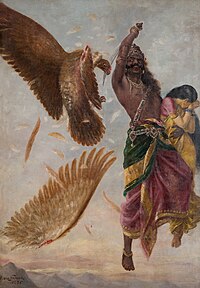Raja Ravi Varma(April 29, 1848 - October 2, 1906) was an Indian painter from the princely state of Travancore who achieved recognition for his depiction of scenes from the epics of the Mahabharata and Ramayana. His paintings are considered to be among the best examples of the fusion of Indian traditions with the techniques of European academic art.
Varma is most remembered for his paintings of beautiful sari-clad women, who were portrayed as shapely and graceful. His exposure in the west came when he won the first prize in the Vienna Art Exhibition in 1873. Raja Ravi Varma died in 1906 at the age of 58. He is considered among the greatest painters in the history of Indian art.
Raja Ravi Varma was born as Ravi Varma Koil Thampuran of Kilimanoor palace( near Thiruvanathapuram ) in the erstwhile princely state of Travancore(thiruvithankur) in Kerala. His father Ezhumavail Neelakanthan Bhattatiripad was an accomplished scholar, and his mother Umayamba Thampuratti (d.1886) was a poet and writer whose work Parvati Swayamvaram would be published by Raja Ravi Varma after her death. His siblings were C. Goda Varma (b.1854), C. Raja Raja Varma (b.1860) and Mangala Bayi Thampuratti, who was also a painter. At a young age he secured the patronage of HH Maharajah Ayilyam Thirunal of Travancore, ( a relative, and began formal training thereafter.He was trained in water painting by Rama Swami Naidu, and later in oil painting by Dutch portraitist Theodor Jenson. Raja Ravi Varma High school for Boys & Girls are situated at Kilimanoor in his memory. There are lot of other cultural organizations throughout Kerala in his name. His palace is nearly 6 Kilometer from Ponganadu and 7.7 kilometer from Pazhayachanda and 36 km from Thiruvananthapuram.
Raja Ravi Varma received widespread acclaim after he won an award for an exhibition of his paintings at Vienna in 1873. Raja Ravi Varma's paintings were also sent to the World's Columbian Exposition held in Chicago in 1893 and he was awarded two gold medals. He travelled throughout India in search of subjects. He often modeled Hindu Goddesses on South Indian women, whom he considered beautiful. Ravi Varma is particularly noted for his paintings depicting episodes from the story of Dushyanta and Shakuntala, and Nala and Damayanti, from the Mahabharata. Ravi Varma's representation of mythological characters has become a part of the Indian imagination of the epics. He is often criticized for being too showy and sentimental in his style. However his work remains very popular in India. His many fabulous paintings are available at Laxmi Vilas Palace of Vadodara.
In 1904 Viceroy Lord Curzon, on behalf of the King Emperor bestowed upon Raja Ravi Varma the Kaiser-i-Hind Gold Medal. At this time his name was mentioned as "Raja Ravi Varma" for the first time, raising objections from Maharajah Moolam Thirunal of Travancore and beides, as per the Marumakkathayam tradition, the name of the maternal uncle (Raja Raja Varma) was prefixed to the
name. Thereafter he was always referred to as Raja Ravi Varma.
In 1993, art critic Rupika Chawla and artist A Ramachandran jointly curated a large exhibition of Raja Ravi Varma's works at the National Museum, New Delhi. Considering his vast contribution to Indian art, the Government of Kerala has instituted an award called Raja Ravi Varma Puraskaram, which is awarded every year to people who show excellence in the field of art and culture.
Jatayu was struck down by demon Ravana
Their eldest son, Kerala Varma, born in 1876 went missing in 1912 and was never heard of again. Their second son was Rama Varma (b.1879), an artist who studied at the JJ School of Arts, Mumbai, married to Srimathi Gowri Kunjamma, sister of Dewan PGN Unnithan.
Raja Ravi Varma's elder daughter, Ayilyam Nal Mahaprabha Thampuran, appears in two of his prominent paintings and was mother of Maharani Sethu Lakshmi Bayi of Travancore. He had another daughter, Thiruvadira Nal
Kochukunji Thampuran, grandmother of Chithira Thirunal Balarama Varma Maharajah. His third daughter, born in 1882, was Ayilyam Nal Cheria Kochamma Thampuran.
His descendants comprise the Mavelikara Royal house while two of his granddaughters, including the said Sethu Lakshmi Bayi, were adopted to the Travancore Royal Family, the cousin family of the Mavelikara House, to which lineage the present Travancore Maharaja Uthradom Thirunal Marthanda Varma belongs. Well known among his descendants are writer Shreekumar Varma (Prince Punardam Thirunal), artists Rukmini Varma (Princess Bharani Thirunal) and Jay Varma, classical musician Aswathi Thirunal Rama Varma and others.
Radha Madavam
The Maharashtrian Lady
Saraswathi
he Lady in the picture is Mahaprabha Thampuratti
of Mavelikara, the artist's daughter and mother
of Mavelikara, the artist's daughter and mother






No comments:
Post a Comment